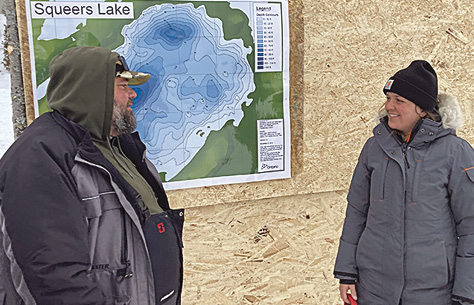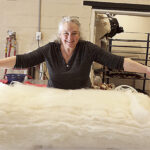Imagine skiing into a remote northern Ontario lake, right past a big sign that says “No Fishing: Provincial Fish Sanctuary.” You ski onward, knowing you have an official invitation in your pocket to do the province a big favor and catch lake trout out of this protected gem—all for the benefit of science. Does this sound like the ultimate fishing dream come true?
The Ontario Ministry of Natural Resources and Forestry’s (OMNRF) Science and Research Branch made this fantasy a reality for anglers over nine days in mid-March at Squeers Lake, in Ontario’s Thunder Bay District. This year, the “Squeers Lake Winter Fishery” was opened to the public for the first time since 2016, meaning that the trout inhabiting the deep, cold water hadn’t seen a hook, line or sinker in seven years.
The Squeers Lake Winter Fishery is an OMNRF-run program aimed at doing scientific research by providing anglers with excellent conditions for catching lake trout, so that the trout can then be sampled and studied by OMNRF technicians. You get to take your catch home with you (up to five lake trout per person). But first you hand your precious research subjects over to a team of prodigious fish processors who gut the trout for you after taking biological samples. The OMNRF gets its data and you get dinner—everybody wins.
The 2023 Squeers Lake Winter Fishery was well advertised. This public engagement really impressed me—an angler from Duluth. Never before had I come across any government actively recruiting anglers. Ontario rocks.
The Fishery was promoted in posts on the “Ontario Fish and Wildlife” page on Facebook starting on January 19, then again on January 24 and February 3. There were articles previewing the fishery in Thunder Bay media like the CBC news website, and there were posters promoting the event in many local outdoor retail shops.
I signed up in February. It took two minutes on Eventbrite. The listing said: “Whether you are an experienced angler or just want to try ice fishing, you are invited to participate. It’s a great opportunity for families or first-time anglers to enjoy a full day of ice fishing on a lake with plenty of fish.” I was in!
The day arrived. My Canadian friends drove us 100 km northwest of Thunder Bay, and we made the mile-and-a-half trek in to Squeers. My heart was beating with expectation and pride when I skied onto the ice and saw the tents (check station) set up by the OMNRF to greet anglers and provide final instructions on this public research endeavor. We each got our License to Collect Fish for Scientific Purposes (a memento to be cherished dearly), and went out fishing.

I spent the next eight hours happily jigging a Little Cleo spoon a couple feet off bottom. While the action wasn’t exactly dream-like, I did get three trout on the ice, which was triple the number I had caught winter-to-date.
According to Tony Trogrlic, an OMNRF technician, the main purpose of the winter fishery is to see how angling pressure affects the fish population of the lake.
“We control entrance to the lake, so we know exactly how many people are fishing,” says Trogrlic. “We know how many fish are removed. We have previous population estimates, and by measuring this year’s harvest, it gives us a really good metric on how angling affects a lake.”
The harvest data from the Winter Fishery allows biologists to estimate the lake trout population size. They can do so by using the number of lake trout tagged the previous fall, which was over 2,000 fish, and the number of those fish that are recaptured in the Winter Fishery. Sure enough, one of the four trout our party caught was tagged.
Blair Wasylenko, Provincial Aquatics Monitoring Program Lead of the OMNRF’s Biodiversity and Monitoring Section explains more about the science.
“Traditionally, the fishery monitored annual sustainability but has since transitioned to monitoring lake trout recovery, which could be done at a five-year interval using the winter fishery,” says Wasylenko. “This process allows our biologists to estimate the lake trout population to inform our provincial broad-scale monitoring of inland lakes program.”
Squeers is a good candidate for this kind of study because it was overfished in the 1970s after a new nearby logging road made fishing there more accessible. The lake was closed to angling in 1979 due to overharvesting, and designated a provincial fish sanctuary in 1981. Since then, the OMNRF has conducted its controlled harvest experiment, using anglers to harvest lake trout.
Back at the check station, Trogrlic and his team are sampling the biological attributes of the fish we brought in: “We analyze each fish’s length, weight, stomach contents, sex, and sample the fish’s inner ear bone (or otolith) to determine its age.”
Fishing for the sake of research is a tough job, but as they say, somebody has to do it.






